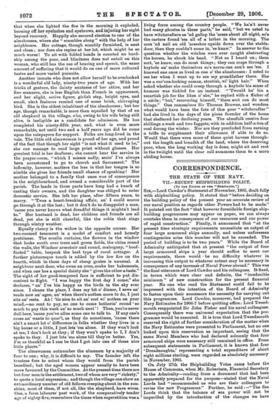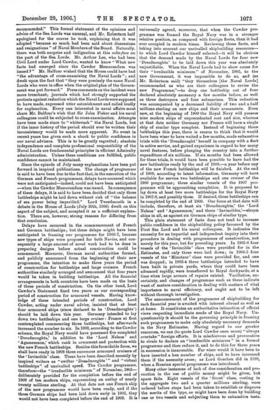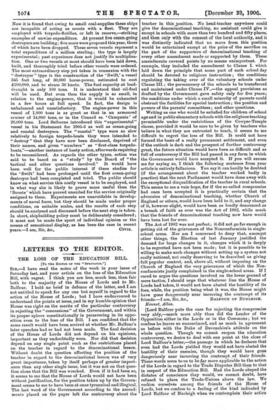CORRESPONDENCE.
THE STATE OF THE NAVY. VII.—RECENT SHIPBUILDING POLICY,
LTO THE EDITOR Or TR& "SPECTATOR,"]
Sin,—Lord Cawdor's Statement of November, 1905, dealt fully with shipbuilding policy. It stated that "before deciding on the building policy of the present year an accurate review of our naval position as regards other Powers had to be made:" It pointed out the fact" that however formidable foreign ship- building programmes may appear on paper, we can always overtake them in consequence of our resources and our power of rapid construction." Finally, it announced that "at the present time strategic requirements necessitate an output of four large armoured ships annually, and unless unforeseen contingencies arise this number will not be exceeded. The period of building is to he two years." While the Board of Admiralty anticipated that at present "the output of four large armoured ships a year should suffice to meet our requirements, there would - be no difficulty whatever in increasing this output to whatever extent may be necessary in consequence of any increase of Naval Power abroad." This was the final utterance of Lord Cawdor and his colleagues. It fixed, in terms which were clear and definite, the "irreducible minimum" of new construction for the present financial year. No one who read the Statement could fail to be impressed with the intention of the Board of .Admiralty to fasten upon their successors the necessity for carrying out this programme. Lord Cawdor, moreover, had prepared the Navy Estimates for 1906-7 before quitting office : Lord Tweed- mouth reappointed Sir John Fisher and his naval colleagues. Consequently there was universal expectation that the pro- gramme would be executed. It is true that Lord Tweedmouth reserved the right of further consideration of the matter when the Navy Estimates were presented to Parliament, but no one looked upon this reservation as important, seeing that the same Naval Members who had declared solemnly that four armoured ships were necessary still remained in office. From subsequent statements in Parliament, it is known that four 'Dreadnoughts,' representing a total expenditure of about eight millions sterling, were regarded as absolutely necessary in November, 1905.
On July 27th the Shipbuilding Votes camp before the House of Commons, when Mr. Robertson, Financial Secretary to the Admiralty—reading from a document that had been apparently prepared for the purpose—stated that the Naval Lords had "recommended us who are their colleagues to revise the new Programme." Further, he said : —" The Sea Lords think that the balance of sea power will not be imperilled by the introduction of the changes we have
recommended." This formal statement of the opinions and advice. of the Sea Lords was unusual, and Mr. Robertson half apologised for the course he took, explaining that it was adopted "because so much had been said about dissensions and resignations" of Naval Members of the Board. Naturally, there was both surprise and indignation at this voile-face on the part of the Sea. Lords. Mr. Arthur Lee, who had been Civil Lord under Lord Cawdor, wanted to know "What new facts had emerged since the Cawdor Memorandum was issued P" Mr. Balfour wished that the House could have had "the advantage of cross-examining the Naval Lords " ; and dwelt upon the fact that "they were precisely the same Naval Lords who were in office when the original plan of the Govern- ment was put forward." Press comments on the incident were more trenchant; journals which had strongly supported the protests against reduction which the Naval Lords were supposed to have made, expressed utter astonishment and called loudly for explanation. Every one interested in naval affairs must share Mr. Balfour's wish that Sir John Fisher and his naval colleagues could be subjected to cross-examination. Attempts have been made since to " whitewash " the Naval Lords, but if the inner history of the period should ever be written their inconsistency would be made more apparent. No event in recent years has given such a shock to public confidence in our naval advisers. This is to be greatly regretted ; absolute independence and complete professional responsibility of the Naval Lords are fundamental principles in efficient Admiralty administration. Unless these conditions are fulfilled, public confidence cannot be maintained.
Since the episode of July many explanations have been put forward in inspired publications. The change of programme is said to have been due to the fact that, in the execution of the German and French programmes, delays have occurred which were not anticipated—indeed, could not have been anticipated —when the Cawdor Memorandum was issued. In consequence of these delays, it is said to have been decided that only three battleships might be laid down without risk of "the balance of sea power being imperilled." Lord Tweedmouth in a debate in the House of Lords (July 30th, 1906) dwelt on this aspect of the subject, and accepted it as a sufficient explana- tion. There are, however, strong reasons for differing from that conclusion.
Delays have occurred in the commencement of French and German battleships ; but these delays might have been anticipated in framing our programme for 1906-7, because new types of ships were proposed for both Navies, and con- sequently a large amount of novel work had to be done in preparing designs before actual construction could be commenced. Moreover, German naval, authorities formed, and publicly announced from the beginning of their new programme, the intention to make three years the period of construction for battleships and large cruisers. French authorities similarly arranged and announced that four years would. be taken in building battleships. All the financial arrangements in both countries have been made on the basis of these periods of construction. On the other hand, Lord Cawdor's Statement fixed two years as our corresponding period of construction for armoured vessels. Having know- ledge of these intended periods of construction, Lord Cawdor, acting under naval advice, insisted that at least four armoured ships (since declared to be 'Dreadnoughts ') should be laid down this year. Germany intended to lay down two battleships and one large cruiser : France at first contemplated commencing three battleships, but afterwards increased the number to six. In 1908, according to the Cawdor scheme, the Royal Navy would have possessed five completed ' Dreadnoughts,' in addition to the Lord Nelson' and Agamemnon,' which rank in armament and protection with the new French battleships. Besides this formidable force, we shall have ready in 1908 three enormous armoured cruisers of the Invincible' class. These have been described recently by inspired writers as "swifter 'Dreadnoughts' and "virtual battleships". of unrivalled speed. The Cawdor programme, therefore—the "irreducible minimum" of November, 1905— deliberately provided for the completion before the end of 1908 of ten modern ships, representing an outlay of nearly twenty millions sterling. At that date not one French ship of the new programme would have been ready, and if the three German ships had been laid down early in 1906, they would not have been completed before the end of 1908. It is
universally agreed, moreover, that when the Cawdor pro- gramme was framed the Royal Navy was in a stronger relative position, as compared with foreign fleets, than it bad ever occupied in modern times. Reviewing these facts, and taking into account our unrivalled shipbuilding resources— to which Lord Cawdor himself referred—it will be obvious that the demand made by the Naval Lords for four new Dreadnoughts' to be laid down this year was absolutely unjustifiable. When the Naval Lords had to show cause for their "irreducible minimum" of November, 1905, to the new Government, it was impossible to do so, and (as Mr. Robertson said) "they themselves [the Naval Lords] recommended us who are their colleagues to revise the new Programme,"—to drop one battleship out of four declared absolutely necessary a few months before, as well as three destroyers and four submarines. This reduction was accompanied by a decreased liability of two and a half millions sterling on new ships and their armaments. Even now, at the beginning of 1909 the Royal Navy will possess nine modern ships of unprecedented cost and size, whereas at that date neither Germany nor France will have a single ship of similar type complete. Instead of beginning three battleships this year, there is reason to think that it would have been wiser to have waited a few months, made exhaustive trials with the 'Dreadnought' herself in company with a fleet in active service, and gained experience in regard to her many novel features, before plunging the country into a further expenditure of six millions. If six months had been allowed for these trials, it would have been possible to have had the new battleships ready by the end of 1909,—a year before any of the new French battleships will be finished. At the end of 1909, according to latest information, Germany will have available for service two battleships and one cruiser of the 1906 programme ; three similar vessels of the 1907 pro- gramme will be approaching completion. It is proposed to lay down at least two more battleships for the Royal Navy in 1907-8, and possibly three. If desired, these battleships can be completed by the end of 1909. Our force at that date will include, therefore, at least six Dreadnoughts,' the Lord Nelson' and Agamemnon,' and three ' Invincibles,'—eleKen ships in all, as against six German ships of similar type.
This plain statement of facts does not tend to increase public confidence in the shipbuilding policy favoured by the First Sea Lord and his naval colleagues. It indicates the necessity for an impartial and independent inquiry into their procedure in dealing with programmes of construction, not merely for this year, but for preceding years. In 1905-6 four vessels of the 'Invincible' class were provided for in the Estimates, and only three were laid down ; in 1904-5 four vessels of the Minotaur' class were provided for, and one was dropped ; in 1903-4 three battleships intended to have been built in private yards, where they could have been advanced rapidly, were transferred to Royal dockyards, at a time when large arrears of repairs existed. Vacillation, un- certainty, and changes of programme such as ,these indicate want of mature consideration in dealing with matters of vital importance to naval efficiency, and ought not to be left without thorough investigation.
The announcement of the programme of shipbuilding for each financial year is awaited with interest abroad as well as at home. It constitutes an authoritative intimation of official views respecting immediate needs of the Royal Navy. Un- questionably it should be the governing principle in framing such programmes to make only absolutely necessary demands in the Navy Estimates. Having regard to our greater resources, we can (to quote Lord Cawdor once more) "always overtake" foreign efforts. It is mischievous and provocative to rivals to declare an "irreducible minimum' in a formal programme and then reduce it, and to do this for three years in succession is inexcusable. Far wiser would it have been to have inserted a less number of ships, and to have increased them if the necessity arose; as Lord Goschen did in 1898, when a Russian special programme was introduced.
Many other instances of lack of due consideration and pre- caution in the use of public money might be given, but space fails. Eight vessels of the Scout ' class, costing in the aggregate two and a quarter millions sterling, were ordered before steps bad been taken to establish or disprove the merits of the type, as might have been done by building one or two vessels and subjecting them to exhaustive tests. Now it is found that owing to small coal-supplies these ships are incapable of acting as scouts with a fleet. They are employed with torpedo-flotillas, or left in reserve,--striking examples of unwise expenditure. At present five ocean-going destroyers are building; five more were proposed this year, three of which have been dropped. These seven vessels represent a total expenditure of a million sterling ; the type is largely experimental ; past experience does not justify its multiplica- tion. One or two vessels at most should have been laid down, built, and thoroughly tried before other vessels were ordered. The most extraordinary step yet taken in connexion with the "
destroyer" type is the construction of the Swift,' a vessel 345 feet long, of 30,000 horse-power, estimated to cost £280,000, and to steam 36 knots. The fuel capacity at load- draught is only 180 tons. It is understood that oil-fuel will be used. But even then the supply is so small, in relation to the engine-power, that it would be exhausted in a few hours at full speed. In fact, the design is unbalanced and unsatisfactory. The engine-power in this vessel of 1,800 tons is as great as that in an armoured cruiser of 14,000 tons, or in the Cunard es. 'Campania' of 20,000 tons. Lord Selborne introduced this "experimental" vessel in his Statement for 1905-6 as well as ocean-going and coastal destroyers. The " coastal " type were so slow relatively to foreign torpedo-boats they were intended to " destroy " that they have now been disclassed, deprived of their names, and given " numbers " as "first-class torpedo- boats,"—another instance of hasty action, afterwards requiring to be reconsidered. As regards the other types, action was said to be based on a "study" by the Board of "the tactical and other questions involved." It would have been well for the public interest if these studies for the Swift' had been prolonged until the first ocean-going destroyer had been completed and tried. The public should know on what service this costly vessel is to be employed, and in what way she is likely to prove more useful than the 'Scouts' which have proved unsuited for the service originally assigned to them. Experiments are unavoidable in develop- ments of naval force, but they should be made under proper conditions, on suitable scales, and the results of each step should be analysed and discussed before the next step is taken. In short, shipbuilding policy must be deliberately considered; it must not be made the sport of individual opinion or the means of sensational display, as has been the case in recent




































 Previous page
Previous page